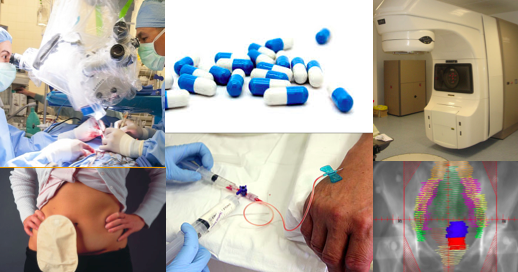|
|
||||||||||||||
|
Cancer treatments What to expect and side effects
|

|
|||||||||||||
New treatments and techniques are emerging from clinical trials every week. Fortunately the chance of being cured or living for a very long time with established disease is increasing significantly. For example, 20 years the average chance of surviving breast cancer was 54 % now it is 84%. The average time to survive prostate cancer which has spread to he bones was 2 years, now it is over 10 years. The latest statistics of cancer incidence and survival can be found on the CRUK website. What's more many patient are living longer and longer with metastatic disease albeit with ongoing medical treatments. Why have cancer outcomes improved? Most people with cancer are now managed by multidisciplinary medical teams which consider the latest guidelines such as those produced by NICE to recommend an optimal care plan. Screening programmes for breast and bowel cancer mean that more patients are presenting at an earlier stage (smaller cancers which have not spread). The time it takes for a patient with suspected cancer to be seen has improved by the 2 week rule in the UK. Radiological and biopsy tools are improving and pathologists have more sophisticated techniques to determine the type of cancer they have and the proteins and genes it over or under expresses which is helping to individualize cancer treatments. Surgical and particularly radiotherapy techniques have dramatically improved, increasing the chance to removing the primary cancer. The support of chemotherapy drugs has improved ensuring more rapid treatment of life threatening complications treatments but the biggest advance has been the discovery and development of new biological treatments which can target specific defects within cancer cells - attacking their Achilles heal. What determines cancer treatments? The choice of cancer treatments given to each patients varies according to a wide range of factors ranging from their type of cancer, The grade (how aggressive it is), the stage (how advanced it is - whether it has spread), whether it is sensitive to hormone therapies, the age and general condition of the patient and more recently whether it expresses specific genetic markers such as Oestrogen receptor, Her2 or Kras. Doctors often use computer programmes such NHS breast cancer predict or the more expensive oncotypeDX. Although these test try to better select patients it still means that patients often have to undergo more intense treatments and have to take them for longer, often leaving them suffering acute and long term side effects. Although some of these often distressing symptoms can be managed with medical treatments most can be alleviated by sensible self help lifestyle strategies. Cancer treatments may involve surgery alone or combined with one or all of the individual therapies listed below. Surgery may recommended be to obtain a diagnosis or to completely excise the cancer. Surgery is usually performed first but is some cases it may be recommended after either chemotherapy or radiotherapy (neo-adjuvant therapy). Radiotherapy Chemotherapy Hormone
therapy Biological
therapy Other
ablative therapies Complementary
therapy |
||||||||||||||




